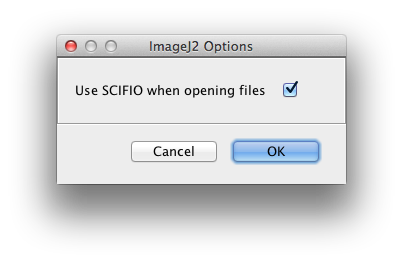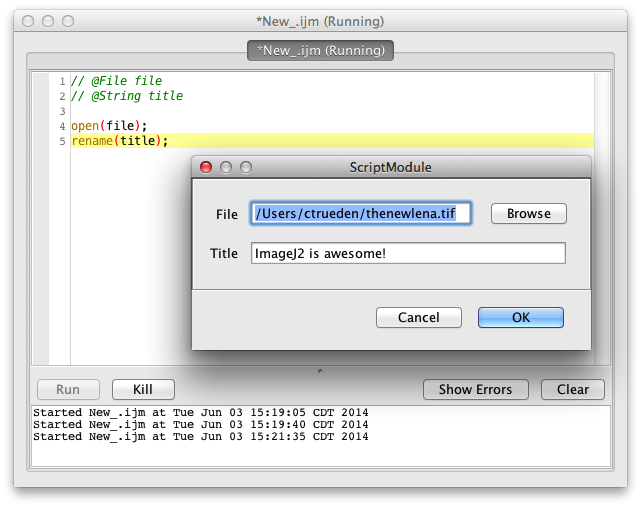Today, the ImageJ team is pleased to announce a public release candidate for ImageJ2: version 2.0.0-rc-2. We tested the first release candidate internally, but now is the time to engage the community: please test the second release candidate with your favorite workflows.
Unlike the beta releases during the past two years, this version of ImageJ2 integrates fully with the legacy ImageJ 1.x user interface. Consequently, this version of ImageJ2 really is the same ImageJ you know and love, achieving 100% backwards compatibility with existing ImageJ 1.x plugins, scripts and macros, while still providing access to the redesigned capabilities of ImageJ2. This allows you to keep using ImageJ in familiar ways, while also enabling migration toward more powerful new features as needed.
The Fiji distribution of ImageJ has bundled ImageJ2 for quite some time, so you may already be familiar with some of ImageJ2’s features, some of which—such as the Updater and Launcher—were originally developed as part of Fiji, now they are part of ImageJ proper. But this release candidate represents the first time Fiji has really been built fully on top of ImageJ2.
Features of ImageJ2
ImageJ2 provides a wealth of new features and capabilities:
- The ImageJ Updater makes it simple to keep your ImageJ up to date, and to add new plugins by enabling additional Update Sites.
- The ImageJ Updater also makes it simple to publish your own tools based on ImageJ, via Personal Update Sites.
- New and enhanced file format support via the SCIFIO library. There is no need to call a special SCIFIO plugin; it works with commands like File › Open automatically. Additional import options are available via the File › Import › Image… command. See the SCIFIO page of the ImageJ wiki for further details.

- New commands:
- Plugins › Debug › Dump Stack for debugging when things hang.
- Plugins › Debug › System Information for reporting on versions of installed plugins and libraries.
- More powerful Script Editor with support for several scripting languages through a generic, consistent scripting framework (see screenshot below).
- Write parameterized commands and scripts:
- Declare typed inputs and outputs with the
@Parameterannotation and let ImageJ handle the user interaction, avoiding any dependence on the AWT user interface (see example below). - Parameter support for scripts and macros (see section below)
- Reusable in many contexts: KNIME, CellProfiler, OMERO, headless…
- Plugins appear in the menu automatically without
plugins.configfiles, and without having to set theplugins.dirproperty to a single directory containing all the .jar files with special naming requirements. - Mix and match ImageJ 1.x and ImageJ2 data structures!
Example:
- Declare typed inputs and outputs with the
import ij.ImagePlus;
import org.scijava.command.Command;
import org.scijava.plugin.Parameter;
import org.scijava.plugin.Plugin;
@Plugin(type = Command.class, menu = "Plugins > Set Image Title")
public class SetImageTitle implements Command {
@Parameter
private ImagePlus imp;
@Parameter
private String title;
@Override
public void run() {
imp.setTitle(title);
}
}
- Easy yet powerful plugin concept—stay tuned for a dedicated blog post soon!
- Use ImageJ2’s N-dimensional ImgLib2-based data structures (still in beta).

Enhanced scripting
ImageJ2 comes with a versatile and elegant scripting framework: all languages can be accessed in the same, consistent way. New languages can be supported by implementing script language plugins; the script editor will automatically support such languages. By default, ImageJ supports Beanshell, Javascript, Jython, JRuby, Clojure, ImageJ 1.x macro and Java “as a script language”. Experimental alpha versions are available for Scala and native Python.
Similar to commands supporting @Parameter annotations asking ImageJ to auto-generate dialogs, scripts support a related concept: By declaring typed variables in commented lines on top of the script, ImageJ (or KNIME, CellProfiler, OMERO, etc) will be asked to auto-generate the appropriate dialogs when executing the scripts.
Identical to thusly parameterized scripts, it is now also possible to declare in ImageJ 1.x macros what input parameters are required (see the ImageJ2 script editor screenshot on the right with a parameterized macro in action).
More than just an application
ImageJ2 breaks the “one developer, one machine, one task” paradigm: it is also a modular collection of highly reusable software libraries built on SciJava, using a powerful plugin framework to facilitate rapid development and painless user customization.
The following software component libraries form the core of ImageJ2:
- ImageJ Common - The core image data model, using ImgLib2.
- ImageJ Ops - An extensible framework for reusable image processing algorithms.
- ImageJ Updater - A mechanism to update individual plugins and libraries within ImageJ.
- ImageJ Legacy - Provides complete backwards compatibility with ImageJ 1.x.
- SciJava Common - The core frameworks for plugins, modules, scripting and the application itself.
How to test the release candidate?
You can either download the .zip file or just update your Fiji installation: ImageJ 2.0.0-rc-2 is already part of Fiji.
Please send all bug reports to the ImageJ mailing list. And thank you very much for trying ImageJ2!